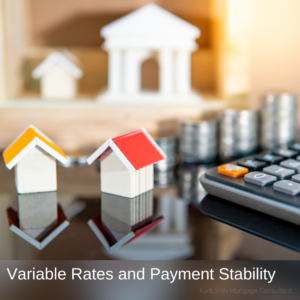
Increasing Rates
With the rapid increases in interest rates this year, borrowers with static payment variable rate mortgages (VRM) won’t see increases to their regular payments, but those with adjustable rate mortgages (ARM) will. Both still have the certainty they won’t have higher penalties as they may if they had fixed rate mortgages, but only a VRM has a payment that typically doesn’t change.
VRM Payments Staying the Same
With a static payment, the amounts going toward interest and principal within your regular payment adjusts as interest rates fluctuate, which can affect the amortization (amount of time it will take to the repay the loan) depending on the direction rates move. Increasing rates can lengthen the amortization unless you make extra payments. Decreasing rates will decrease the amortization again.
Trigger Rate
As rates rise, the VRM rate may reach a level at which the payment no longer covers 100% of the interest due within a given payment period. When that happens, none of the principal is paid down by the mortgage payment. One of our VRM lenders calls this the Trigger Rate. The full amount of the payment would be applied to interest, and the mortgage balance would begin to rise by the amount of the interest owing for the payment period that isn’t repaid.
Trigger Point
This lender will work with the borrower if the balance of the mortgage reaches a point where:
- the mortgage balance exceeds 80% of the fair market value as determined by the lender for uninsured mortgages
or - the mortgage balance exceeds 105% of the opening balance of the mortgage for insured mortgages.
This lender calls this the Trigger Point. At this point, the lender will ask their VRM clients to make a lump sum payment, increase their payments, or lock in to a fixed rate mortgage. Reaching the Trigger Point could take a long time in most cases with a VRM mortgage, but the possibility must be considered in determining the suitability of this mortgage type in your situation.
Creating A Buffer
On a 30 year amortization, paying bi-weekly will knock 4.5 years off the life of your mortgage and will create a buffer for lengthening amortizations, as would making lump sum payments as interest rates rise. Setting your payment to the fixed rate payment you would have made, had you taken a fixed rate, is another way to build in a buffer. If you get a raise or bonuses, you could make a few more lump sum payments along the way as well to help keep your principal balance heading in the right direction.
Renewal
When the renewal date arrives at the end of the term, the mortgage reverts back to the remaining original amortization period and the payment is reset based on rates available at that time. If you took a 30 year mortgage and five years passes, your new payment will be based on a 25 year amortization. If your balance is higher due to interest rate increases, you would have a higher payment at renewal than you might expect. The extent to which that payment will be higher will depend on your mortgage balance and renewal rates at that time. Depending on whether you built in a buffer or not, that payment difference can be mitigated by the buffer you build in.
Moving to a static payment variable rate may come at a cost and not mortgages are created equal. As always, this information is subject to change and lender approval, but let me know if you have questions on whether a static payment VRM would work for you. I am always happy to help.